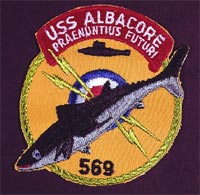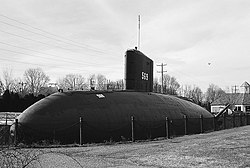USS Albacore (AGSS-569)

USS Albacore off the coast of Rhode Island
|
|
| History | |
|---|---|
|
|
|
| Name: | Albacore |
| Namesake: | Albacore |
| Ordered: | 24 November 1950 |
| Builder: | Portsmouth Naval Shipyard of Kittery, Maine |
| Laid down: | 15 March 1952 |
| Launched: | 1 August 1953 |
| Sponsored by: | Mrs. J.E. Jowers, the widow of Chief Motor Machinist's Mate Arthur L. Stanton, lost with the second Albacore (SS-218) |
| Commissioned: | 6 December 1953 |
| Decommissioned: | 9 December 1972 |
| Struck: | 1 May 1980 |
| Motto: |
|
| Status: | Donated as a museum and memorial in Portsmouth, New Hampshire |
| Badge: |  |
| General characteristics | |
| Displacement: | 1240 tons light, 1540 tons full, 300 tons dead |
| Length: | 62.1 meters (204 ft) overall, 60.9 meters (200 ft) waterline |
| Beam: | 8.2 meters (27 ft) |
| Draft: | 6.7 meters (22 ft) |
| Propulsion: | Two Diesels, one electric motor |
| Speed: |
|
| Range: | varied with configuration |
| Complement: | 5 officers, 49 men |
| Armament: | none |
|
USS Albacore (Submarine)
|
|

USS Albacore on display in Portsmouth, NH, March 2006
|
|
| Location | Portsmouth, New Hampshire |
|---|---|
| Built | 1953 |
| Architect | Portsmouth Naval Shipyard |
| NRHP Reference # | 89001077 |
| Significant dates | |
| Added to NRHP | 11 April 1989 |
| Designated NHL | 11 April 1989 |
USS Albacore (AGSS-569) was a unique research submarine that pioneered the American version of the teardrop hull form (sometimes referred to as an "Albacore hull") of modern submarines. The revolutionary design was derived from extensive hydrodynamic and wind tunnel testing, with an emphasis on underwater speed and maneuverability. She was the third ship of the United States Navy to be named for the albacore, a small tuna found in temperate seas throughout the world.
Her keel was laid down on 15 March 1952 by the Portsmouth Naval Shipyard of Kittery, Maine. She was launched on 1 August 1953, sponsored by Mrs. J.E. Jowers, the widow of Chief Motor Machinist's Mate Arthur L. Stanton, lost with the second Albacore (SS-218), and commissioned on 6 December 1953 with Lieutenant Commander Kenneth C. Gummerson in command.
The effectiveness of submarines in World War II convinced both the Soviets and the United States Navy that undersea warfare would play an even more important role in coming conflicts and dictated development of superior submarines. The advent of nuclear power nourished the hope that such warships could be produced. The effort to achieve this goal involved the development of a nuclear propulsion system and the design of a streamlined submarine hull capable of optimum submerged performance.
Late in World War II, committees on both sides of the Iron Curtain studied postwar uses of atomic energy and recommended the development of nuclear propulsion for ships. Since nuclear power plants would operate without the oxygen supply needed by conventional machinery, and since techniques were available for converting carbon dioxide back to oxygen, submarine designers turned their attention to vessels which could operate for long periods without surfacing. Veteran submariners visualized a new type of submarine in which surface performance characteristics would be completely subordinated to high submerged speed and agility. In 1949 a special committee began a series of hydrodynamic studies which led to a program within the US Bureau of Ships to determine what hull form would be best for submerged operation. The David Taylor Model Basin tested a series of designs. The best two—one with a single propeller and the other with dual screws—were then tested in a wind tunnel at Langley Air Force Base. The single-screw version was adopted, and construction of an experimental submarine to this design was authorized on 25 November 1950. Albacore introduced HY-80 high-strength steel (then called low-carbon HTS (High Tensile Steel)), with a yield strength of 80,000 psi (550 MPa), although this was not initially used to increase the diving depth relative to other US submarines. HY-80 remained the standard submarine steel through the Los Angeles class. This ship was classified as an auxiliary submarine (AGSS-569) and named Albacore.
...
Wikipedia

